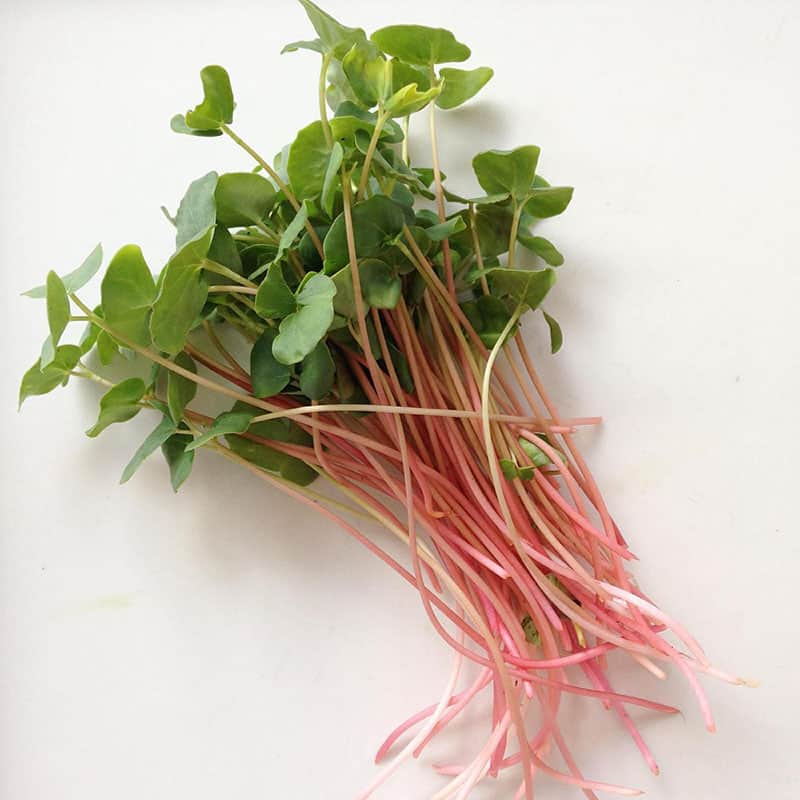Contrary to popular belief, microgreens are of different types too. Therefore, each kind of microgreen requires specialized care. And one of those microgreens happens to be buckwheat microgreens. As a microgreen enthusiast, I often get asked how to grow buckwheat microgreens and if it is difficult to grow? How do I take care of my buckwheat microgreen?

If these questions fumble you, don’t worry. In this article, I’ll answer how to grow buckwheat microgreens, and what buckwheat microgreen is? how to take care of it and much more.
How To Grow Buckwheat Microgreens
Growing buckwheat microgreens is a simple and rewarding process that can be done year-round. All you need is a container, some potting mix, and some buckwheat seeds.
To get started, fill your container with potting mix and dampen it with water. Then, sprinkle a thin layer of buckwheat seeds over the surface of the soil. Be sure to avoid overcrowding the seeds, as this will result in spindly microgreens. Once the seeds have been planted, cover the container with a lid or plastic wrap to create a humid environment.

The microgreens will sprout in 3-5 days. When they are 1-2 inches tall, they are ready to harvest. Simply snip them off at the base with scissors and enjoy!
How To Grow Buckwheat Microgreens
Step-by-Step Process
Growing buckwheat microgreens is a simple and rewarding process that can be done year-round. With just a few supplies and a little bit of care, you can enjoy fresh, nutrient-rich greens in as little as two weeks.
Here’s everything you need to know to get started.
To begin, you’ll need some Buckwheat seeds, a container with drainage holes, some potting mix or coco coir, and a watering can. Once you have your supplies gathered, fill your container with potting mix or coco coir and moisten it with water. Next, scatter your Buckwheat seeds evenly over the surface of the mix. You don’t need to worry about covering them, as they don’t need darkness to germinate. Finally, give them a good misting with your watering can and place the container in a bright spot out of direct sunlight.
You’ll need to keep an eye on your seeds and mist them regularly to ensure that the potting mix stays moist but not soggy. In about 7-10 days, you should see your first seedlings emerging. Once they’ve reached about 2 inches in height, they’re ready to harvest.
To do so, simply snip them off at the base with a pair of sharp scissors. Be sure to wash them thoroughly before consuming them.
Enjoy your fresh, nutrient-packed microgreens as is, or use them to add a zesty flavor and vibrant color to salads, wraps, and other dishes.
Caring for Your Buckwheat Microgreen
Once your buckwheat microgreen has germinated, it doesn’t require much care. water it when the soil dries out, and make sure it gets plenty of sunlight. When the greens are ready to harvest, cut them at the base with scissors and enjoy!
Buckwheat microgreens are a nutritious and flavorful addition to any meal. With just a little bit of care, you can enjoy them year-round.
Now that you know how to grow buckwheat microgreens, let’s talk about the buckwheat microgreen
What Are Buckwheat Microgreens?
Buckwheat microgreens are simply young buckwheat plants that are harvested before they reach maturity. They are a nutritious and flavorful addition to any meal and can be enjoyed year-round with just a little bit of care.
Buckwheat microgreens are the baby version of buckwheat greens, and they pack a serious nutritional punch. These tiny greens are loaded with vitamins A, C, and E, as well as minerals like magnesium, potassium, and iron.
In addition, buckwheat microgreens contain high levels of antioxidants and phytonutrients. While they can be enjoyed raw in salads or sandwiches, their slightly nutty flavor also pairs well with cooked dishes. Whether you’re looking to boost your health or add some flavor to your meals, buckwheat microgreens are a great option.
What Do Buckwheat Microgreens Taste Like?
Buckwheat microgreens have a nutty flavor with a slightly sweet taste. The texture is similar to wheatgrass, with a crunch from the stem. When eaten raw, they have a slightly bitter taste. Buckwheat is also used in savory dishes, such as soups and stir-fries.
The greens can be wilted and added to dishes at the end of cooking, or they can be sauteed with other vegetables. Buckwheat microgreens are a good source of vitamins A, C, and E, as well as calcium, magnesium, and iron. They are also rich in antioxidants and phytochemicals. Buckwheat microgreens are considered a superfood because of their nutritional value. They can be eaten raw or cooked, and they can be added to smoothies, salads, sandwiches, soups, and stir-fries.
Health Benefits of Buckwheat Microgreens
Microgreens are a type of vegetable that is harvested when the plant is still young. They are usually no more than a couple of inches tall and are often used as a garnish or to add color to a dish. However, microgreens are more than just a pretty face – they also pack a nutritional punch.
Buckwheat microgreens, in particular, are a good source of vitamins A, C, and E, as well as iron and magnesium. They also contain high levels of antioxidants, which can help to protect cells from damage. In addition, buckwheat microgreens have been shown to lower cholesterol levels and blood pressure. As a result, they may offer some protection against heart disease and stroke.
So next time you’re looking for a way to add some extra nutrition to your diet, reach for some buckwheat microgreens.
Conclusion
To grow buckwheat microgreens, start by soaking the seeds in water for 12 hours. Then, drain the seeds and place them on a damp paper towel. Roll the towel up and place it in a dark, warm location for 24 hours. After that, plant the seeds in the soil and water them regularly. Once the seedlings are 2-3 inches tall, they’re ready to harvest! To do so, simply cut them at the base with a sharp knife.
Enjoy your fresh, nutritious microgreens alone, or add them to a salad or other dish.
I hope now you know how to grow buckwheat microgreens.

